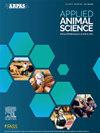Review: Mycotoxins in ruminant livestock production: An underestimated and overlooked risk and opportunity?
IF 1.5
Q3 AGRICULTURE, DAIRY & ANIMAL SCIENCE
引用次数: 0
Abstract
Purpose
This review summarizes currently available information relevant to potential risk and possible justi- fied response to mycotoxin exposure in ruminant livestock. Two basic questions are addressed: primarily, have my- cotoxins been underestimated or overlooked in ruminant production, and, if so, what remediations are practically available?
Sources
The information in this review came from scientific journals and professional meeting proceedings. Summary data from a proprietary company database are used to support relevant research findings.
Synthesis
Published literature supports the hypoth- esis that ruminant susceptibility to mycotoxin exposure poses a more significant hazard than historically assumed. Estimates of exposure have been restricted by testing pro- tocols and by failure to account for all potential toxin sources, additive and synergistic effects, and the effects of chronic low-level exposure. Mycotoxins can cause diverse short- and long-term negative outcomes with potential to reduce performance, efficiency, and health. Various my- cotoxin remediation products have been evaluated and employed. Although additional research is needed, it ap- pears that those combining proven, targeted sequestration agents with ingredients known to deactivate specific toxins or support the animal’s natural defense systems represent the most efficacious approach.
Conclusions and Applications
Continued improve- ment in mycotoxin awareness and management may allevi- ate a potential limiting factor in dairy and beef produc- tion. Broader assessment of actual animal exposure across a range of feeding programs and environments is needed to better understand mycotoxin hazards. Additional research should further clarify modes of action and metabolic im- pacts specific to ruminants, better quantify related production losses, and provide comparative assessments of specific remediation programs.
回顾:反刍家畜生产中的真菌毒素:被低估和忽视的风险和机遇?
目的 本综述总结了目前与反刍家畜接触霉菌毒素的潜在风险和可能的合理应对措施有关的信息。本综述涉及两个基本问题:首先,在反刍动物生产过程中,霉菌毒素是否被低估或忽视;如果是,有哪些切实可行的补救措施。综述已发表的文献支持这样一种假设,即反刍动物对霉菌毒素暴露的易感性所造成的危害比以往假设的更为严重。对暴露量的估计受到测试方法的限制,而且未能考虑到所有潜在的毒素来源、叠加效应和协同效应以及长期低水平暴露的影响。霉菌毒素可造成各种短期和长期的负面影响,并有可能降低性能、效率和健康水平。已经对各种霉菌毒素修复产品进行了评估和使用。尽管还需要进行更多的研究,但目前看来,那些将经过验证的、有针对性的螯合剂与已知可使特定毒素失活或支持动物自然防御系统的成分相结合的产品是最有效的方法。为了更好地了解霉菌毒素的危害,需要对动物在各种饲养计划和环境中的实际接触情况进行更广泛的评估。其他研究应进一步阐明反刍动物特有的作用模式和代谢影响,更好地量化相关的生产损失,并对具体的补救方案进行比较评估。
本文章由计算机程序翻译,如有差异,请以英文原文为准。
求助全文
约1分钟内获得全文
求助全文

 求助内容:
求助内容: 应助结果提醒方式:
应助结果提醒方式:


